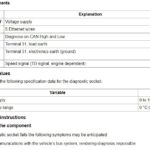Swapping engines can be a rewarding project, especially when you’re looking to boost the performance of your vehicle. If you’re considering putting a Lincoln Mark VIII engine into another car, like a Ford Thunderbird, one of the first questions you’ll likely encounter is about engine management systems and compatibility. Specifically, you might be asking: is the 1996 Mark VIII OBD2?
The answer is yes, the 1996 Lincoln Mark VIII is OBD2 compliant. This is a crucial point to understand because OBD2 (On-Board Diagnostics II) is a standardized system that provides real-time data about your vehicle’s performance and diagnostics. This system became mandatory for all cars sold in the United States starting in 1996, which places the ’96 Mark VIII squarely in the OBD2 era.
However, just knowing it’s OBD2 is only the starting point, especially when you’re undertaking an engine swap. Let’s delve into why this matters and what you need to consider for a successful project, drawing from expert insights in engine modification.
When dealing with a 1996 Mark VIII engine, recognizing its OBD2 nature is essential for several reasons:
-
Diagnostics and Tuning: OBD2 compliance means you have access to a wealth of diagnostic information. Standard OBD2 scanners and software can be used to read trouble codes, monitor engine parameters, and ensure everything is running correctly after your swap. Furthermore, for tuning purposes, OBD2 systems are widely supported by aftermarket tuning solutions, giving you flexibility in optimizing your engine’s performance, especially if you’re making modifications like adding Cobra cams.
-
PCM Considerations: The Powertrain Control Module (PCM) is the brain of your engine management system. For the ’96 Mark VIII, the PCM is designed for OBD2 operation. While some earlier Ford models (OBD1) might have PCMs favored for certain modifications due to more aggressive timing advance, this isn’t relevant for your situation with a ’96 Mark VIII engine.
-
Wiring and Harness Compatibility: When swapping engines, wiring is often a significant hurdle. For the Mark VIII, you’ll need to consider the PCM wiring and how it integrates with your project car. It’s highly recommended to compare the pinouts of both the Mark VIII PCM and the PCM of the vehicle you’re installing the engine into (e.g., Thunderbird). This ensures all wires are correctly placed, preventing potential electrical issues. You might need to repin the harness to match the requirements.
-
Intake Manifold Runner Control (IMRC): The Mark VIII engine may have features like IMRC, which optimizes airflow into the engine at different RPMs. The Mark VIII PCM controls this, and you’ll need to ensure this functionality is maintained in your swap. If you consider using a Thunderbird PCM, you might need to add wiring for IMRC control or use a window switch. Alternatively, you could explore having the Thunderbird PCM flashed to control the IMRC using an unused wire.
-
Fan Control System Differences: Another critical area is the cooling fan control. The Mark VIII uses a Variable Control Relay Module (VCRM) for its single-speed, high-current cooling fan, often employing Pulse Width Modulation (PWM) for variable speed. In contrast, a Thunderbird might use an Integrated Relay Control Module (IRCM) with a two-speed fan (high/low, without PWM). These differences in fan control mechanisms need careful consideration to ensure proper engine cooling in your swapped vehicle.
Considering these points, particularly the complexities around wiring and module differences, the most straightforward approach for a successful and reliable engine swap is often to use the Thunderbird engine harness on the Mark VIII motor and have the Thunderbird PCM reflashed to be compatible with the Mark VIII engine, especially when incorporating Cobra cams. This strategy helps minimize wiring headaches and ensures the PCM is correctly calibrated for the engine’s specifications and modifications.
While using the original Mark VIII PCM and harness is possible, it may introduce more complexity in integrating different control modules and adapting to the target vehicle’s electrical system. For a smoother swap and optimal performance, especially with modifications like Cobra cams, reflashing the Thunderbird PCM for the Mark VIII engine configuration is a highly recommended path by experienced mechanics.
Remember, engine swaps require meticulous planning and attention to detail. Understanding that the 1996 Mark VIII is OBD2 compliant is just the first step. Carefully addressing PCM compatibility, wiring, and control system differences will contribute significantly to a successful and high-performing engine swap project.
